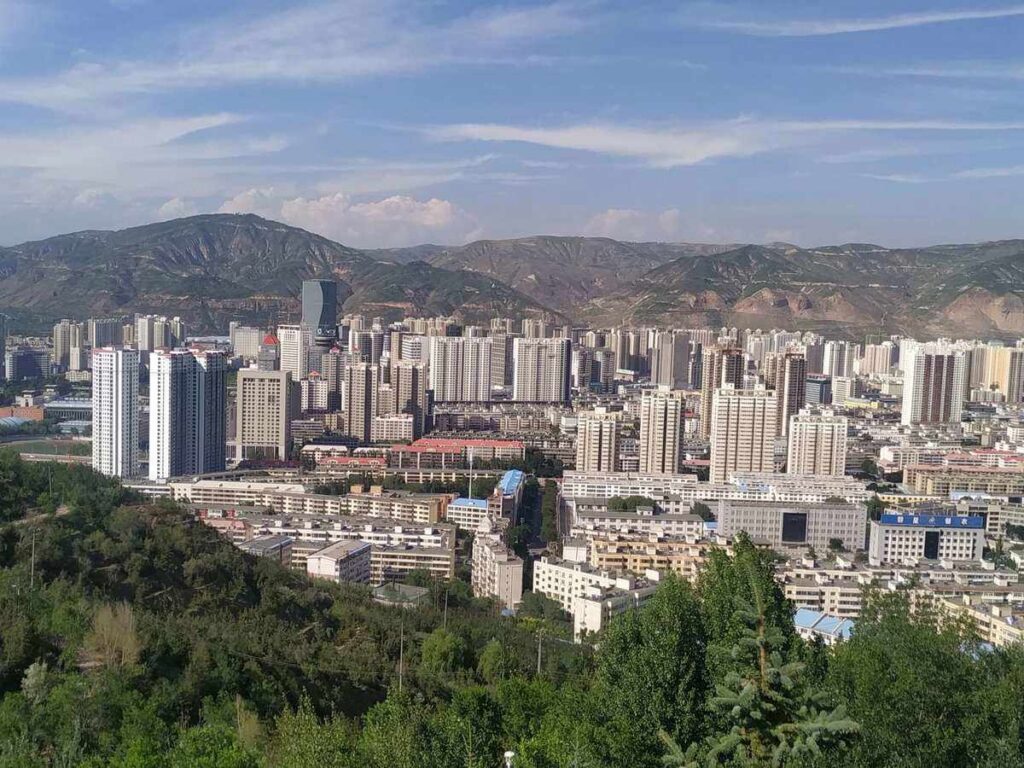
Xining, known as Siling in Tibetan, Xining is one of the major gateways to the Tibetan Plateau. It is an ancient highland city on the Yellow River which offers many scenic spots and historical sites. Although the city has a strong Islamic flavor, as it is home to many Hui people, you will start getting a more Tibetan feel as you move away from the city. Xining has a history of over 2,100 yearsand was a chief commercial hub on the Hexi Corridor caravan route to Tibet, handling especially timber, wool and salt in ancient times. Just outside the city are many famous monasteries, national parks, and nomadic grasslands worth visiting.
Geography and Location:
Xining is situated in the northeastern part of the Tibetan Plateau, at an altitude of about 2,200 meters (7,200 feet) above sea level. It lies near the confluence of the Dzongchu River and the Yellow River, making it an important regional waterway. Its location has made it a key stop for trade and cultural exchange between Tibet, China, and Central Asia for centuries.
Historical Significance:
Xining has a long history that dates back over 2,000 years. It was historically a center for both Tibetan Buddhism and Chinese culture. The region was a key location during the Tang Dynasty and the Ming Dynasty, and over time, it became an important political and religious center for the Amdo region of Tibet.
During the Qing Dynasty, Xining became the political capital of the Qinghai region and developed into a major military and administrative center. Today, it serves as the capital of Qinghai Province and plays a central role in regional governance and development.
Tibetan Culture:
Xining is home to a large Tibetan population, and Tibetan Buddhism is an important part of life in the city. Many Tibetan Buddhists from surrounding areas, including the Amdo region, come to Xining for religious and cultural reasons.
The city is close to several key Tibetan Buddhist monasteries, including the Kumbum Monastery (Ta’er Monastery), which is one of the six great monasteries of the Gelug tradition and the birthplace of Je Tsongkhapa, the founder of the Gelug school of Tibetan Buddhism. Kumbum Monastery is an important site for Tibetan pilgrims, and it plays a vital role in preserving Tibetan Buddhist culture and philosophy.
Religious Sites:
Ta’er Monastery (Kumbum Monastery): Located just outside Xining, this monastery is a major pilgrimage site for Tibetan Buddhists, particularly those in the Amdo region. The monastery is renowned for its history, beautiful architecture, and as the birthplace of the famous Tibetan Lama Tsongkhapa.
Other Tibetan Buddhist Temples and Monasteries: Xining is also home to other Buddhist temples and Tibetan cultural centers, as well as a variety of Tibetan-style stupas and prayer wheels scattered throughout the city.
Modern Xining:
In recent decades, Xining has seen rapid development, with new infrastructure, roads, and buildings transforming it into a modern city. Despite its modernization, Xining retains a strong connection to its Tibetan heritage, with markets, festivals, and local traditions reflecting its Tibetan and Chinese influences. The city is known for its vibrant markets, especially those selling traditional Tibetan goods, prayer items, and textiles.
Population and Ethnicity:
Xining is ethnically diverse, with Tibetans making up a significant portion of the population, alongside Han Chinese, Hui Muslims, and various other ethnic groups. The presence of Tibetan and Hui communities in the city gives Xining a unique cultural blend of Tibetan Buddhism and Islamic traditions. This multicultural aspect is reflected in the city’s food, architecture, and local customs.
Xining as a Transportation Hub:
Xining is an important transportation hub in the region, especially since it is the gateway for travelers heading into the Tibetan Plateau. The Xining–Lhasa Railway, a part of the Qinghai–Tibet Railway, connects the city to Lhasa (the capital of Tibet) and plays a crucial role in the movement of people and goods between Tibet and the rest of China. The city’s location also makes it a key stop for buses and trains heading into the Tibetan regions.
Climate:
Xining has a semi-arid climate with cold winters and mild summers, which is typical of regions located at high altitudes. Winters are generally cold and dry, with snowfall common, while summers are warm and comfortable. The city experiences a fair amount of sunshine throughout the year, which contributes to its reputation as a pleasant place to visit.
Tourism and Culture:
As a destination for tourists interested in Tibetan culture, Xining offers a unique opportunity to experience the blend of Tibetan and Chinese traditions. Some notable attractions include:
Dongguan Mosque: An important mosque in the city reflecting the local Hui Muslim community’s influence.
The annual Xining Snow Mountain Music Festival and other cultural events showcase the city’s diverse cultural fabric, and the city’s proximity to Tibetan areas like Golok and Yushu also make it a great base for exploring more remote Tibetan regions.
Challenges and Development:
While Xining has thrived in many ways, it also faces challenges related to its rapid growth, such as balancing modernization with the preservation of traditional Tibetan culture and religious practices. The city’s increasing connection to the Chinese government and the integration of the region into broader Chinese infrastructure projects have led to concerns about the preservation of Tibetan identity.
In Summary:
Xining is a vibrant city that serves as a cultural and economic bridge between the Tibetan Plateau and the rest of China. It’s a place where Tibetan traditions coexist with modern Chinese influences, making it a unique city for those interested in Tibetan culture, Buddhist studies, and the history of the Tibetan people. Whether you’re visiting the important Kumbum Monastery, exploring the markets, or learning about the rich history of the Amdo region, Xining offers a fascinating glimpse into Tibetan life outside of the Tibet Autonomous Region (TAR).
 Tibet World Travel Tibet Tour, Tibet Trip, Tibet Travel, Tibet Train, Tibet Trekking,
Tibet World Travel Tibet Tour, Tibet Trip, Tibet Travel, Tibet Train, Tibet Trekking,
